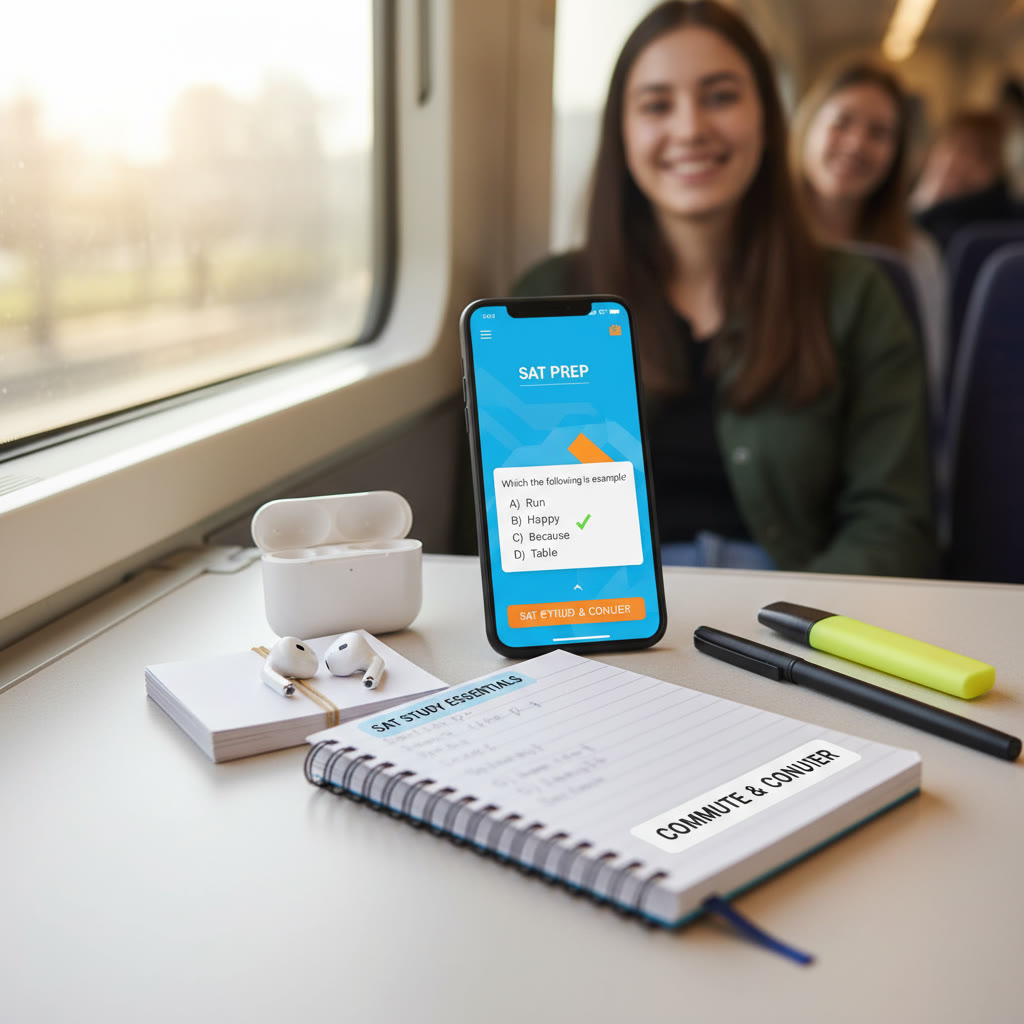Make Every Mile Count: SAT Prep During Long Commutes
Long commutes used to feel like stolen time: a blur of brake lights and podcasts that never quite landed. What if that repetitive routine could become one of your most productive study windows for the SAT? Whether you ride a train, sit on a bus, or are a passenger for an hour each day, commute time can be a gentle, low-stress way to chip away at preparation without burning out after school. This guide turns your commute into a purposeful, flexible, and even enjoyable study habit.
Why commute study works (and when it doesn’t)
There are three big reasons commuting can be great for SAT prep: consistency, microlearning, and low pressure. First, a daily commute creates a reliable, recurring block of time. Second, the fragmentary nature of travel—repeated 20–60 minute stretches—fits perfectly with microlearning: short, focused bursts that accumulate. Third, studying on the go often demands lower-intensity work, which minimizes burnout.
But a warning: not all study is safe or effective while commuting. If you’re driving, safety is the absolute priority—no screens, no problem-solving with a pen. If you are a distracted passenger on a bumpy road, dense algebra or complex error analysis might not be the best choice. The trick is to match activities to the commute context.
Understand the SAT structure so you target your commute time
Before you plan sessions, know what you’re preparing for. The current SAT is organized into two main sections: Evidence-Based Reading and Writing (Reading and Writing & Language) and Math (with a no-calculator portion and a calculator portion). The usual timing breakdown is Reading: 65 minutes for 52 questions; Writing & Language: 35 minutes for 44 questions; Math: 80 minutes total split into a 25-minute no-calculator section (20 questions) and a 55-minute calculator section (38 questions). Scores range from 400 to 1600.
With that in mind, your commute can handle specific SAT tasks: audio explanations and vocabulary practice for Reading; listening to grammar tips and sentence structure lessons for Writing; conceptual math reviews and formula-memorization for Math—saving full practice sections for quiet study at home.
What to bring: your commute study kit
Creating a small, portable kit will reduce friction and make it easier to start every time you sit down. Your kit should be compact and commuter-friendly.
- Smartphone or mp3 player with downloaded audio lessons and podcasts (offline mode).
- Noise-cancelling or good-quality earbuds for focused listening in a noisy environment.
- Index cards or a flashcard app for vocabulary and formulas; physical cards are great for tactile learners.
- A small notebook and a pen for quick math scratch work (only if you’re not driving).
- Headphones splitter or Bluetooth if you want to study with a friend occasionally.
- Portable charger so your devices don’t die mid-session.
Image ideas


Match activities to commute types
Every commute is different. Below are practical recommendations based on three common scenarios: passive (you’re a passenger or on public transit), moving but steady (long metro ride), and active driving (you’re behind the wheel).
Public transit / passenger in car (best for mixed activities)
This is prime time. You can mix audio lessons, flashcards, light readings, and scratch-work math. Use noise-cancelling headphones to create a mini study room.
- Listening: 15–30 minute concept videos or audio lessons on math topics (algebra, functions, geometry), grammar rules, or reading passage strategies.
- Active recall: 10-minute flashcard rounds for vocabulary or math formulas.
- Practice problems: Work through a 10–15 minute set of 1–3 focused problems for speed and method practice.
Long metro or steady bus ride (best for long-form audio and reading)
When you have 45–90 minutes on a single stretch, deeper work becomes possible: full audio lectures, long reading passage annotations in your head, and systematic vocabulary review.
- Read-ahead mentally: Skim a passage at home, then re-listen to an explanation during your commute and mentally summarize each paragraph. This trains comprehension speed.
- Timed mental drills: Time yourself silently on two passages or a group of math problems and then check work afterward.
Driving (only audio-based, safety first)
If you drive, the commute is audio-only. Use it for high-yield listening: mnemonic-based vocabulary, conceptual math explanations, and strategy discussions. Avoid anything requiring visual attention or writing.
- Vocabulary via mnemonics and usage examples—listen and repeat aloud quietly to reinforce memory.
- Concept summaries: short, 5–10 minute breakdowns of algebra, geometry, or grammar rules.
- Stress-reduction: short breathing or visualization exercises to reduce test anxiety before you get home to study more deeply.
Practical commute study schedules
Here are sample schedules for different commute lengths. Use them as templates and adjust to your strengths and test timeline.
| Commute Length | Primary Focus | Sample Activities | Frequency |
|---|---|---|---|
| 15 minutes | Quick review | 5 min vocab flashcards, 10 min audio concept | Daily |
| 30 minutes | Targeted practice | 10 min flashcards, 15 min audio lesson, 5 min journaling summary | 5 times/week |
| 60 minutes | Deep learning | 20 min audio lecture, 20 min problem solving, 20 min review/notes | 3–4 times/week |
| 90+ minutes | Simulated focus | Full audio walkthrough of a passage, 40 min math practice, 10–20 min reflection | 1–2 times/week |
Example 30-minute commute session (step by step)
Try this compact but powerful routine:
- Minutes 0–5: Warm-up—quick review of 10 flashcards (vocabulary or formulas).
- Minutes 5–20: Focused audio lesson—a single concept explained with examples (for math or grammar).
- Minutes 20–28: Active problem—one or two practice questions related to the concept; if you can’t write, solve them mentally and mark answers to check later.
- Minutes 28–30: Quick summary—mentally state one key takeaway and one question to review later at your desk.
Strategies that work especially well on the go
Active listening and mental annotation
Listening isn’t the same as learning. Turn passive audio into active study by mentally annotating: pause mentally to summarize, predict the next step, or argue with the narrator. When you’re on transit, repeat phrases silently or aloud to reinforce retention.
Spaced repetition with flashcards
Spaced repetition software (SRS) like Anki is built for micro-sessions. Short daily encounters with vocabulary or problem types produce excellent long-term memory gains. Carry a physical stack of 10–20 index cards for quick analog sessions if you prefer paper.
Mental math and shorthand practice
Train to do simpler computation in your head during commutes: percent-change estimates, squaring tricks, and algebraic rearrangements. Practice writing compact solutions in a pocket notebook once parked. Over time, translating mental work to written solutions becomes faster.
Chunking reading practice
For reading comprehension, chunk paragraphs into one-sentence summaries in your head. For each paragraph: identify the main idea, tone, and one detail you’d use as evidence. This approach strengthens speed and comprehension without needing to annotate on paper.
Record your thought process
Consider recording brief voice notes after a practice question: state what you did and why. Later, these quick reflections form a valuable archive of mistakes and insights—perfect for discussion with a tutor or for reviewing at home.
When to schedule full practice tests
Long commutes are excellent for targeted work, but full-length practice tests—timed, quiet, and complete—should be done in a stable environment. Use commute study to shore up weaknesses and build stamina between full tests. For most students, a realistic rhythm is 1 full practice test every 2–3 weeks, increasing frequency as the exam approaches.
Tracking progress and staying motivated
Small wins matter. Track what you do each commute: topics covered, flashcards reviewed, and mistakes recorded. Over time, your commute log will show accuracy trends and highlight stubborn concepts.
Motivation comes from seeing progress. Celebrate consistent micro-streaks: a week of daily 20-minute commutes spent reviewing quadratic equations? Reward yourself. Remember: a thousand small, focused sessions beat a few intense, exhausted crams.
How personalized guidance can amplify commute study
Some students thrive with a coach who helps structure those on-the-go minutes. If you want targeted accountability and a study plan that uses commute time efficiently, consider Sparkl’s personalized tutoring. Tutors can design short, high-yield micro-lessons to listen to on the train, select flashcards tailored to your weaknesses, and use AI-driven insights to track progress. The combination of 1-on-1 guidance, tailored study plans, and expert tutors helps convert commute consistency into measurable score gains.
Sample week: combining commute study with home practice
This sample balances commuting and longer home sessions over a seven-day period for someone with a 45-minute daily commute.
- Monday commute: Vocabulary SRS + 20-minute audio lesson on linear equations.
- Evening at home: 45 minutes practicing 6–8 math problems from that lesson, review mistakes.
- Tuesday commute: Grammar audio + editing practice aloud.
- Evening at home: Timed 25-minute no-calculator math mini-section.
- Wednesday commute: Reading passage strategies audio + mental summarizing of a short passage.
- Evening at home: Complete and score a 30-minute reading section; review question types missed.
- Thursday commute: Flashcards + recorded reflection of week’s trouble spots to send to your tutor or save for review.
- Friday commute: Light review—listen to recorded explanations for earlier mistakes to reinforce corrections.
- Weekend: Full-length practice test or focused timed section, with commute used for review playback and flashcards.
Troubleshooting common commute-study problems
I get distracted on the bus or train
Use shorter tasks. If background noise is the issue, noise-cancelling headphones help. If your mind wanders, try 10-minute focused sprints with a built-in reward: a song, a quick Instagram check, or a small snack at the end of the sprint.
I forget to review mistakes later
Create a “commute mistakes” voice note or a single notebook page where you immediately write one line about the mistake. At home, triage these into a weekly review session. You can also use Sparkl’s personalized tutoring to get regular check-ins where a tutor helps track and remediate recurring errors.
I’m overwhelmed by what to study
Start with 2–3 recurring targets—vocab, one math topic, and reading strategy. Depth beats breadth. Use commute time to maintain momentum on these small targets rather than trying to cover everything every day.
Final tips: balance, safety, and mindset
Balance. Use commutes for steady progress, but preserve at-home time for deep, high-focus work. Safety. Never study visually while driving. If you’re prone to motion sickness, prioritize audio. Mindset. Reframe your commute from lost time to invested time. Over a month, a 45-minute daily commute becomes fifteen hours of structured study—enough to master vocabulary lists, reinforce key math formulas, or read dozens of passages.
Commute study is not a magic bullet, but it is a powerful multiplier when paired with deliberate practice. With consistent micro-sessions, a curated kit, and occasional tailored help from a coach—like Sparkl’s personalized tutoring for targeted lessons and AI-driven progress tracking—you can make travel time an engine of improvement.
Parting thought
Imagine arriving at your desk at the end of a commute with one new idea lodged in your head, one mistake clearly remembered, and one small victory behind you. Those tiny deposits, compounded day after day, become confidence on test day. The road doesn’t have to slow you down—let it help you speed up.
Now take out one index card, download a 10-minute concept lesson, and try this on your next ride. Small, consistent moves win the SAT race.













No Comments
Leave a comment Cancel